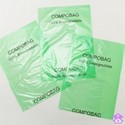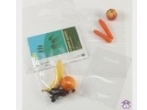Please choose a vault from below or make a deposit...
adj. biodegradable bags
Capable of being decomposed by biological agents, especially bacteria: a biodegradable detergent.
Conventionally, plastics are made of polymers derived from fossil fuel. These types of plastics are used worldwide � particularly in packaging and household applications. The benefits of low production costs, light weight, strength, relative imperviousness to gas and water, clarity, and printability are highly regarded, but the final disposal of used flexible plastics causes problems. The ever increasing use of plastics, particularly in packaging, has become a significant source of environmental pollution (litter) and created problems in waste management. If disposed of by landfill, the plastics worsen the shortage of landfill sites. If the plastics are incinerated, they can emit poisonous gases such as dioxins. These problems motivate the public to take more care of the environment. Making plastic bags biodegradable is one way to try to ease the task of waste reduction.
There are two main options for converting normal polythene into a biodegradable film:
(1) Starch based or Biobased (Hydrodegradable) It is made from corn (otherwise known as maize), potatoes or wheat. These forms of biodegradable films meets the ASTM standard (American Standard for Testing Materials) and European norm EN13432 for compostability as it degrades at least 60% within 180 days or less.
(2) Additive based (Oxodegradable/Photodegradable film) These films are made by blending an additive to provide a UV or oxidative and/or biological mechanism to help degrade them. This process typically takes 6 months to 2 years in a landfill site and/or standard composting system. In these films, biodegradation is a two stage process; firstly the plastic is converted by reaction with oxygen (light, heat and/or stress) to molecular fragments that water can wet, and then these smaller oxidised molecules are biodegraded as well, i.e. converted into carbon dioxide, water and biomass by microorganisms.
 Shopping > Packaging > carrier bags
Shopping > Packaging > carrier bags
 Shopping > Packaging > Biodegradable bags
Shopping > Packaging > Biodegradable bags
 Shopping > Packaging > Biodegradable bags
Shopping > Packaging > Biodegradable bags
 Shopping > Packaging > Biodegradable bags
Shopping > Packaging > Biodegradable bags
 Shopping > Packaging > Biodegradable bags
Shopping > Packaging > Biodegradable bags
 Shopping > Packaging > Biodegradable bags
Shopping > Packaging > Biodegradable bags
 Shopping > Packaging > Biodegradable bags
Shopping > Packaging > Biodegradable bags
 Shopping > Packaging > Biodegradable bags
Shopping > Packaging > Biodegradable bags
 Shopping > Packaging > Biodegradable bags
Shopping > Packaging > Biodegradable bags
 Shopping > Packaging > Biodegradable bags
Shopping > Packaging > Biodegradable bags
 Shopping > Packaging > Biodegradable bags
Shopping > Packaging > Biodegradable bags
 Shopping > Packaging > Biodegradable bags
Shopping > Packaging > Biodegradable bags
 Shopping > Packaging > Biodegradable bags
Shopping > Packaging > Biodegradable bags
 Shopping > Packaging > Biodegradable bags
Shopping > Packaging > Biodegradable bags
 Shopping > Packaging > Biodegradable bags
Shopping > Packaging > Biodegradable bags
 Shopping > Packaging > Biodegradable bags
Shopping > Packaging > Biodegradable bags